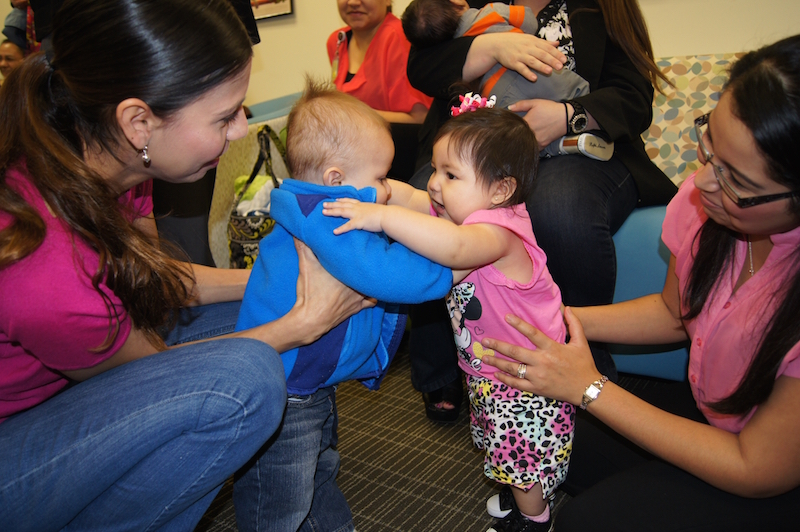
Share On Social!
This is part of our Latina Mom and Baby Health: A Research Review »
The importance of healthy habits for babies
As we have discussed, a mother’s physical activity level during pregnancy and early infant breastfeeding practices both play an important role in limiting the risk of childhood obesity among Latino youths.
Within the first year of life, infants experiencing rapid weight gain are more likely to become overweight in later years.156–159
As such, it is critical that parents continue to promote healthy eating habits and physical activity for their children during infancy and early childhood in order to encourage a healthy weight for life.
This is particularly important for Latino families, as there is a higher rate of obesity among Latino preschoolers in the United States compared with non-Latino white youths.1,160
Latino parents and problematic infant feeding habits
In 2014, a randomized obesity prevention trial investigated racial and ethnic trends in infant feeding and activity behaviors among parents of 2-month-old infants.161 The trial enrolled 863 parents (50% Latino) and reported the prevalence of behaviors thought to relate to later obesity.
Importantly, study investigators found that potentially obesogenic feeding behaviors were already prevalent at this early age, such as exclusive formula feeding in 45 percent of the total study population and early introduction of solid food in 12 percent.
In addition, practices such as bottle propping (enabling babies to drink from a bottle without the assistance of a parent or caretaker) (23%), putting infants to bed with bottles (43%), always feeding when the infant cried (20%), and always encouraging infants to finish their milk (38%) were also prevalent.
When considering racial and ethnic differences, Latino parents were more likely than non-Latino whites to encourage infants to finish feeding or engage in bottle propping behavior.161
Latino parents and problematic infant activity habits
In terms of physical activity and sedentary practices, behaviors linked to obesity were also highly prevalent at this early age.16
The same 2014 study evaluated markers of physical activity including infant tummy time, television exposure, and active television watching, in accordance with AAP recommendations.
Television watching is discouraged in all children younger than 2;162 and at least 30 minutes of tummy time, which helps infants strengthen their muscles, is recommended per day.163
According to the study investigators, parental adherence to these recommendations was low.161
Nearly 50 percent of all parents reported active television watching among their infants, with over 90 percent reporting that infants had exposure to television throughout the day.161
For Latinos, 41 percent of infants took part in active television watching for more than 25 minutes per day, with a mean daily television exposure time of 228 minutes (or 3.8 hours).
In addition to sedentary screen time, only 34 percent of all parents reported providing their infants with the recommended physical activity of ≥30 minutes of tummy time per day. Tummy time was lowest among Latino infants (22%) compared with non-Latino black or non-Latino white infants (45% and 46%, respectively).161
These findings indicate that by the age of 2 months, behaviors discouraging physical activity and promoting sedentary behavior and unhealthy eating are already prevalent among Latino infants and their parents.161
More from our Latina Mom and Baby Health: A Research Review »
- Introduction & Methods
- Key Research Finding: Maternal obesity
- Key Research Finding: Breastfeeding
- Key Research Finding: Breastfeeding promotion
- Key Research Finding: Marketing of infant formula
- Key Research Finding: Latino infant habits (this section)
- Key Research Finding: Early childcare settings
- Policy Implications
- Future Research Needs
References for this section »
135. Wright A, Rice S, Wells S. Changing hospital practices to increase the duration of breastfeeding. Pediatrics. 1996;97(5):669-675.
136. Frank DA, Wirtz SJ, Sorenson JR, Heeren T. Commercial discharge packs and breast-feeding counseling: effects on infant-feeding practices in a randomized trial. Pediatrics. 1987;80(6):845-854.
137. Caulfield LE, Gross SM, Bentley ME, et al. WIC-based interventions to promote breastfeeding among African-American Women in Baltimore: effects on breastfeeding initiation and continuation. J Hum Lact Off J Int Lact Consult Assoc. 1998;14(1):15-22.
138. Romero-Gwynn E. Breast-feeding pattern among Indochinese immigrants in northern California. Am J Dis Child. 1989;143(7):804-808.
139. Ryan AS, Wysong JL, Martinez GA, Simon SD. Duration of breast-feeding patterns established in the hospital. Influencing factors. Results from a national survey. Clin Pediatr (Phila). 1990;29(2):99-107.
140. Feldman-Winter L, Grossman X, Palaniappan A, et al. Removal of industry-sponsored formula sample packs from the hospital: does it make a difference? J Hum Lact Off J Int Lact Consult Assoc. 2012;28(3):380-388. doi:10.1177/0890334412444350.
141. Sadacharan R, Grossman X, Matlak S, Merewood A. Hospital discharge bags and breastfeeding at 6 months: data from the infant feeding practices study II. J Hum Lact Off J Int Lact Consult Assoc. 2014;30(1):73-79. doi:10.1177/0890334413513653.
142. WHO | International Code of Marketing of Breast-Milk Substitutes. WHO. 1981. http://www.who.int/nutrition/publications/code_english.pdf. Accessed June 10, 2015.
143. IBFAN: State of the Code by Country 2011. http://ibfan.org/art/Blue-SOC-2011.pdf. Accessed June 11, 2015.
144. Dodgson JE, Watkins AL, Bond AB, Kintaro-Tagaloa C, Arellano A, Allred PA. Compliance with the International Code of Marketing of breast-milk substitutes: an observational study of pediatricians’ waiting rooms. Breastfeed Med Off J Acad Breastfeed Med. 2014;9(3):135-141. doi:10.1089/bfm.2013.0096.
145. AAP Section on Breastfeeding. Divesting from Formula Marketing in Pediatric Care. https://www2.aap.org/breastfeeding/files/pdf/DivestingfromFormulaMarketinginPediatricCare.pdf.
146. Breastfeeding WG on. Breastfeeding and the Use of Human Milk. Pediatrics. 1997;100(6):1035-1039. doi:10.1542/peds.100.6.1035.
147. New York State Department of Health. New York State Model Hospital Breastfeeding Policy. New York State Dep Heal. 2011. https://www.health.ny.gov/community/pregnancy/breastfeeding/docs/model_hospital_breastfeeding_policy.pdf. Accessed October 6, 2015.
148. Philipp BL, Radford A. Baby-Friendly: snappy slogan or standard of care? Arch Dis Child Fetal Neonatal Ed. 2006;91(2):F145-F149. doi:10.1136/adc.2005.074443.
149. Merewood A, Mehta SD, Chamberlain LB, Philipp BL, Bauchner H. Breastfeeding rates in US Baby-Friendly hospitals: results of a national survey. Pediatrics. 2005;116(3):628-634. doi:10.1542/peds.2004-1636.
150. Breastfeeding: Data: mPINC: 2007: Tables 5.1a-5.2a|DNPAO | CDC. http://www.cdc.gov/breastfeeding/data/mpinc/data/2007/tables5_1a-5_2a.htm. Accessed June 10, 2015.
151. Breastfeeding: Data: mPINC: 2009: Tables 5.1a-5.2a|DNPAO | CDC. http://www.cdc.gov/breastfeeding/data/mpinc/data/2009/tables5_1a-5_2a.htm. Accessed June 10, 2015.
152. Breastfeeding: Data: mPINC: 2011: Tables 5.1a-5.2a|DNPAO | CDC. http://www.cdc.gov/breastfeeding/data/mpinc/data/2011/tables5_1a-5_2a.htm. Accessed June 10, 2015.
153. Breastfeeding: Data: mPINC: 2013: Tables 5.1a-5.2a | DNPAO | CDC.
154. Nelson JM, Li R, Perrine CG. Trends of US Hospitals Distributing Infant Formula Packs to Breastfeeding Mothers, 2007 to 2013. Pediatrics. 2015;135(6):1051-1056. doi:10.1542/peds.2015-0093.
155. Sadacharan R, Grossman X, Sanchez E, Merewood A. Trends in US hospital distribution of industry-sponsored infant formula sample packs. Pediatrics. 2011;128(4):702-705. doi:10.1542/peds.2011-0983.
156. Baird J, Fisher D, Lucas P, Kleijnen J, Roberts H, Law C. Being big or growing fast: systematic review of size and growth in infancy and later obesity. BMJ. 2005;331(7522):929. doi:10.1136/bmj.38586.411273.E0.
157. Taveras EM, Rifas-Shiman SL, Belfort MB, Kleinman KP, Oken E, Gillman MW. Weight status in the first 6 months of life and obesity at 3 years of age. Pediatrics. 2009;123(4):1177-1183. doi:10.1542/peds.2008-1149.
158. Taveras EM, Rifas-Shiman SL, Sherry B, et al. Crossing growth percentiles in infancy and risk of obesity in childhood. Arch Pediatr Adolesc Med. 2011;165(11):993-998. doi:10.1001/archpediatrics.2011.167.
159. Gillman MW. The first months of life: a critical period for development of obesity. Am J Clin Nutr. 2008;87(6):1587-1589.
160. Centers for Disease Control and Prevention. Vital signs: obesity among low-income, preschool-aged children–United States, 2008-2011. MMWR Morb Mortal Wkly Rep. 2013;62(31):629-634. doi:mm6231a4 [pii].
161. Perrin EM, Rothman RL, Sanders LM, et al. Racial and ethnic differences associated with feeding- and activity-related behaviors in infants. Pediatrics. 2014;133(4):e857-e867. doi:10.1542/peds.2013-1326.
Explore More:
Healthy Families & SchoolsBy The Numbers
142
Percent
Expected rise in Latino cancer cases in coming years



